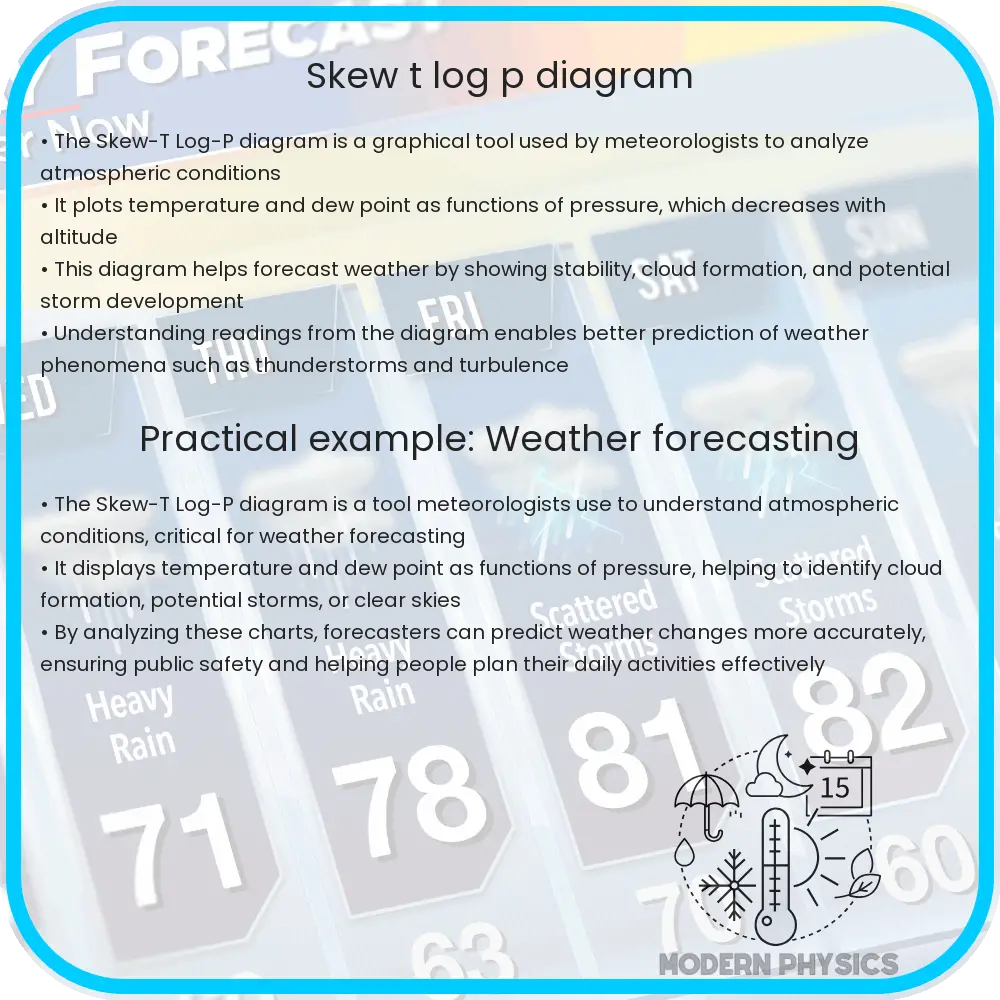Learn the importance of the Skew-T Log-P diagram in meteorology for analyzing atmospheric conditions to predict weather patterns effectively.

Understanding the Skew-T Log-P Diagram in Weather Forecasting
The Skew-T Log-P diagram is an essential tool used by meteorologists to analyze atmospheric conditions. This diagram helps experts to predict weather patterns, including storms and temperature changes, by presenting a detailed representation of the temperature, pressure, and moisture profiles in the atmosphere. Understanding how to interpret these diagrams can provide deep insights into weather forecasting.
Basic Structure of the Skew-T Log-P Diagram
The Skew-T Log-P depicts temperature and pressure in a unique way that helps meteorologists grasp changes in the atmosphere more intuitively. The ‘Skew-T’ part of the name refers to the temperature lines which are plotted at an angle (or skewed) rather than vertically. The ‘Log-P’ part indicates that the pressure scale is logarithmic, which effectively compresses the vertical scale to accommodate a wide range of altitudes within a compact area of the chart.
- Temperature (T): Represented by skewed lines that run from the bottom left to the top right of the diagram.
- Dew Point (Td): Plotted on the same skewed scale as temperature but typically appears to the left of the temperature profile, illustrating moisture content in the air.
- Pressure (P): Shown along the vertical axis on a logarithmic scale, with surface pressure at the bottom and lower pressures, corresponding to higher altitudes, at the top.
Reading the Diagram
To read a Skew-T Log-P diagram, meteorologists evaluate the plotted lines of temperature and dew point against the context of the pressure scale:
- Identify the Temperature and Dew Point Lines: Temperature is usually plotted in red, and dew point in blue. The closer these two lines are, the higher the relative humidity.
- Analyze the Lapse Rates: The change in temperature with altitude, or lapse rate, can indicate stability in the atmosphere. A rapid decrease in temperature with height (steep lapse rate) points to unstable air, which could lead to stormy weather.
- Detect Wind Speed and Direction: Wind barbs are often included on the right side of the diagram, providing information about the wind at different altitudes.
Applications in Weather Forecasting
The Skew-T Log-P diagram is not just a tool for visualizing data but is also pivotal in decision-making processes in meteorology. For instance:
- Storm Prediction: By examining instability and moisture levels represented in the diagram, forecasters can predict the potential development of thunderstorms or tornadoes.
- Turbulence Analysis: Turbulence for aviation can often be forecasted by observing the wind shear and temperature inversions in the upper levels of the atmosphere.
- Cloud Formation and Ceilings: The Skew-T can help determine cloud base heights and the potential for cloud formation by comparing the dew point and temperature profiles.
With these foundational understandings, meteorologists use the Skew-T Log-P diagram as a daily tool in their analytical arsenal, influencing everything from aviation forecasts to public weather notifications. By mastering this complex chart, weather experts can provide precise and life-saving forecasts, proving just how vital the Skew-T Log-P diagram is in the field of meteorology.
Challenges and Limitations
While the Skew-T Log-P diagram is immensely useful, it does come with its own set of challenges and limitations:
- Data Accuracy: The accuracy of predictions based on the Skew-T Log-P diagram heavily depends on the quality and timeliness of the atmospheric data fed into it. Inaccurate or outdated data can lead to incorrect interpretations.
- Complexity: For newcomers, the Skew-T Log-P diagram can appear daunting due to its complex structure and the dense information it presents. Training and experience are crucial to interpret the diagrams effectively.
- Isolated Tool: It’s important to remember that the Skew-T Log-P diagram is just one tool among many in meteorology. It works best when used in conjunction with other meteorological instruments and models to provide a comprehensive view of weather patterns.
Conclusion
The Skew-T Log-P diagram is a cornerstone in the toolkit of meteorologists, offering detailed snapshots of atmospheric conditions that are invaluable for weather forecasting. From predicting severe storms to understanding air stability, the diagram serves multiple purposes and aids in critical decision-making processes. Despite its complexity and the steep learning curve associated with it, the benefits of mastering the Skew-T Log-P diagram are immense. Coupled with other meteorological tools and continuous data updates, it empowers meteorologists to provide accurate, timely, and potentially life-saving weather forecasts. As technology advances and more accurate data becomes available, the effectiveness and reliability of using Skew-T Log-P diagrams are expected to enhance, further solidifying its role in the ever-evolving field of meteorology.
